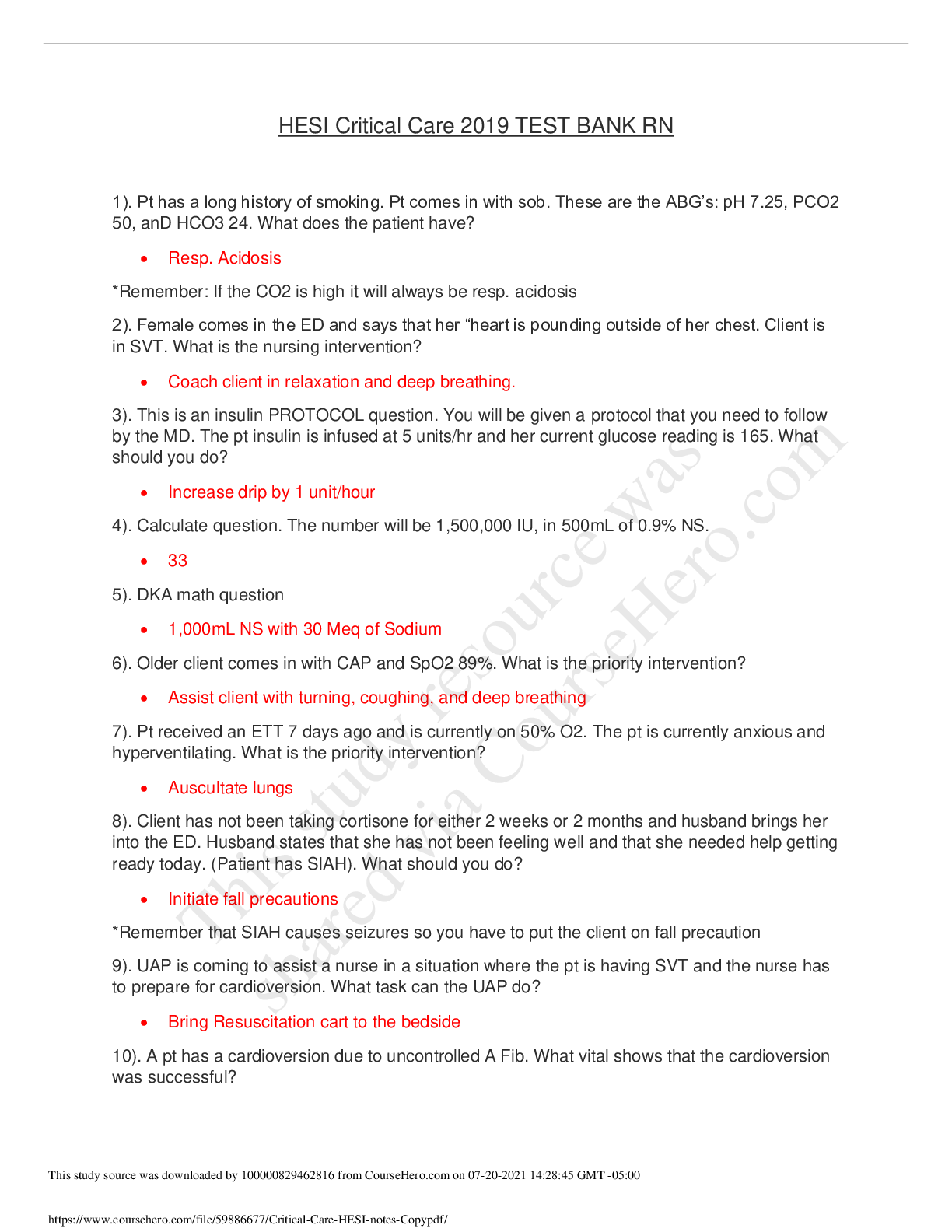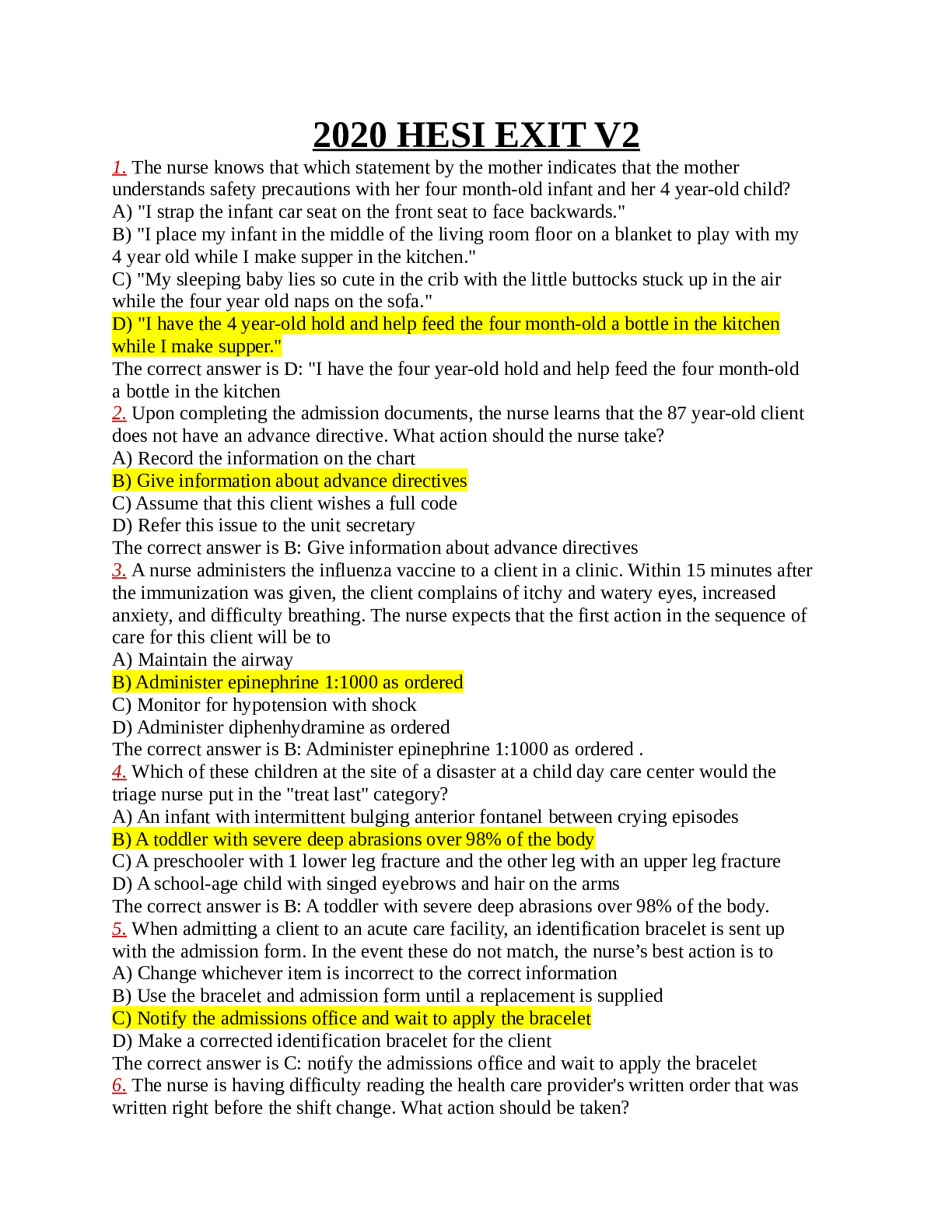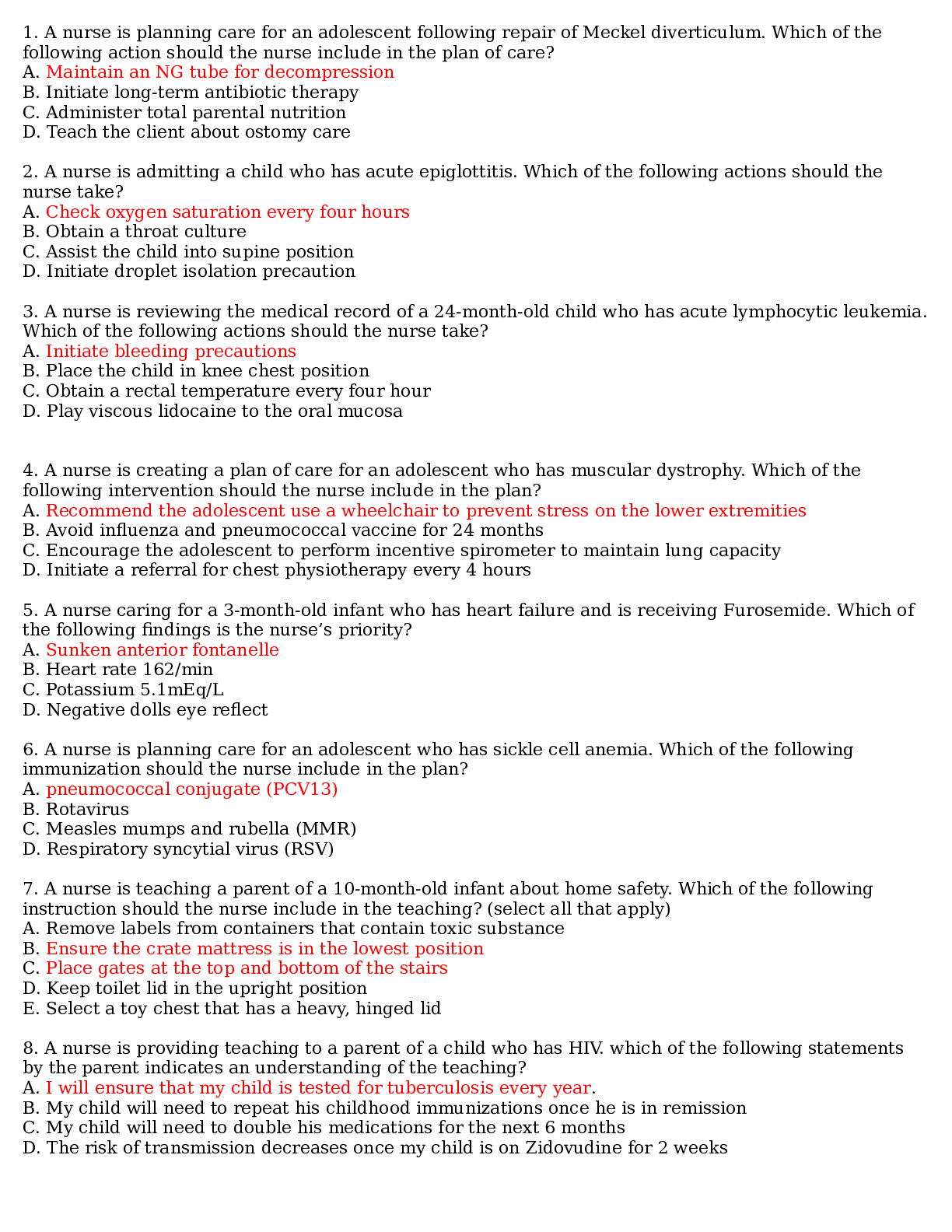*NURSING > HESI > HESI A2 Critical Thinking. 80 Questions and Answers. and situations. See description for the questio (All)
HESI A2 Critical Thinking. 80 Questions and Answers. and situations. See description for the questions listing.
Document Content and Description Below
Critical Thinking 1. The Patient: A 65-year- old male. The Situation: The family brings the patient to the emergency room because he just took an entire bottle of pills. The Question: What action ... should the nurse take first? 2. The Patient: An 80 year-old male who has used continuous oxygen for the past three years. The Situation: While making a home visit, the wife tells the nurse that her husband was doing well on 2 litres of oxygen per minute until late last night when he developed severe shortness of breath on the way to the bathroom. The Question: What action should the nurse take first? 3. The Patient: A 41-year-old male. The Situation: The patient is complaining of severe stomach pain and states that he has been “vomiting all the time.” The Question: What should the nurse do first? 4. The Patient: The wife of a wealthy owner of the town’s bank. The Situation: The patient and her husband arrive on the unit. While orienting the patient to the hospital room, the nurse notices that the patient has placed a large amount of cash and some expensive earrings in the drawer of the bedside table. The Question: What is the best action for the nurse to take? 5. The Patient: A 45-year-old female who is 5’ 2” tall, weighs 200 pounds, and has smoked since age 21. The Situation: The patient comes to the clinic with a complaint of “leg pain.” The Question: It is most important for the nurse to obtain information about which previous occurrence? 6. The Patient: A 61-year-old female. The Situation: The patient has a fever of unknown origin. The nurse administered a fever-reducing medication 30 minutes ago. At this time there has been no decrease in the patient’s fever. The Question: What action would be best for the nurse to take? 7. The Patient: A 70-year-old male who is relatively healthy. The Situation: A liquid mediation is prescribed for this patient. The Question: Prior to administering the prescribed medication, what intervention has the highest priority? 8. The Patient: A fifty-eight-year-old female. The Situation: While the nurse is offering the patient her morning medications, she tells the nurse that she does not recall ever taking a pill that was pink-colored. The Question: What should the nurse do in response to this patient’s comment? 9. The Patients: 1. A 63-year-old with a burn on the left lower leg who is complaining of pain. 2. A 45-year-old with pneumonia, complaining of shortness of breath. 3. A 31-year-old with abdominal pain who has just vomited blood. 4. An 88-year-old who has right-sided paralysis and wants to be helped to the bathroom immediately. The Situation: The nurse is caring for these patients. The Question: Who should the nurse see first? 10. The Patients: 1. A 13-year-old female with a kidney infection who reports that there is “lots of blood” in her urine. 2. An 18-year-old male with acute alcohol poisoning who is seeing “bugs on the walls.” 3. A 21-year-old female with inflammatory bowel disease who has soaked a dressing three hours after surgery. 4. A 25-year old male who is sobbing in his room after being told that he has testicular cancer. The Situation: The nurse is caring for these four patients. The Question: Who should the nurse see first? 11. The Patients: 1. A 42-year-old with diabetes who is blind and is asking to get up and moved to a chair. 2. An 88-year-old with lower body paralysis who wants to be turned in bed. 3. A 17-year-old with asthma who smokes and has been in the bathroom for 30 minutes. 4. A 55-year-old with cardiac disease who tells the nurse, “Get the TV fixed or I am leaving this place.” The Situation: The nurse is caring for these four patients. The Question: Which patient should the nurse see first? 12. The Patient: An elderly female accompanied by her middle-aged son. The Situation: The patient is being discharged after 15-day stay on the medical unit, and the son offers the nurse a box of candy as a gesture of thanks for caring for his mother. The Question: What should the nurse do in response to the offer of this gift? 13. The Patient: A 25-year-old female who has smoked since age 12. The Situation: The patient is complaining of “skipped heart beats.” The Question: Which instruction is most important for the nurse to provide this patient? 14. The Patient: A frail 88-year-old male who has recently become slightly confused. The Situation: The nurse is making a home visit and assesses the safety features of the home environment. The Question: Which suggestion would be most important for the nurse to provide the family? 15. The Patient: A 55-year-old female with a family history of hypertension. The Situation: The patient is concerned about her health and states, “I have had severe headaches for the last six months. I think I might have high blood pressure.” The nurse determines that the woman’s blood pressure is 138/86 (high normal). The Question: What action would be best for the nurse to take? 16. The Patient: A 35-year-old female with a history of asthma. The Situation: The patient has been using a steroid inhaler because she is short of breath. However, she states that her shortness of breath is “no better.” The Question: What is the most important information for the nurse to obtain? 17. The Patient: An older confused male. The Situation: At 3 a.m. the patient, who thinks he is in the bathroom, defecates in the bed. The bed needs to be changed. However, there are no bed sheets on the nursing unit. The Question: What action should the nurse take first? 18. The Patient: A 25-year-old female hospitalized for anorexia. The Situation: The charge nurse denies the patient permission to pass dinner trays. The Question: What is the most important reason for the nurse to deny this anorexic patient permission to pass the dinner trays? 19. The Patient: A 75-year-old male who had a heart attack four years ago. The Situation: The patient tells the nurse, “Even though I stopped smoking 10 years ago, I have a terrible cough.” The Question: What action should the nurse take first? 20. The Patient: A 70-year-old man dying of prostate cancer. The Situation: Nurse “A,” who is charge of a medical unit, notices that a dying patient continues to moan in pain after receiving intravenous injections of morphins whenever Nurse “B” is caring for him. Nurse “A” suspects that Nurse “B” may be diluting the patient’s dose and taking the morphine to feed an addiction. The Question: What should Nurse “A” do in this situation? 21. The Patient: A 29-year-old male. The Situation: A lower leg cast was applied yesterday to a fractured leg. Today the patient tells the nurse that he is in “terrible pain.” The Question: Which action is most important for the nurse to take? 22. The Patient: A 54-year-old male who weighs 275 pounds. He is 5’ 10” tall and has many family members who have died of heart disease. The Situation: He comes to the clinic stating that he has had several episodes of “chest pain” in the last week. The Question: What is the most important action for the nurse to take? 23. The Patient: A 7-year-old child. The Situation: A nurse arrives with an injection containing preoperative sedation that must be given to the child now. The child asks the nurse if the shot will hurt. The Question: What response should the nurse offer to this child? 24. The Patient: A 35-year-old female. The Situation: The patient is admitted with a diagnosis of abdominal pain and diarrhea. The Question: Which action should the nurse take first? 25. The Patient: A 51-year-old male. The Situation: The patient is pale, has dark circles under his eyes, and responds to questions with a soft, low voice. He tells the nurse that he has not slept well for months, but denies any type of pain. The Question: What information is most important for the nurse to obtain? 26. The Patient: A 19-year-old male who has previously been healthy. The Situation: The patient complains that he is losing weight despite “eating all the time.” The Question: Considering this patient’s age and complaint, which diagnostic test is likely to provide the most important information? 27. The Patient: An adult with diabetes mellitus who was just given a morning does of insulin which lowers the blood sugar. The Situation: The patient’s breakfast tray arrives, and the nurse notices that the pancake syrup and sugar packets have not been substituted with products containing artificial sweeteners. The Question: What should the nurse do first in this situation? 28. The Patient: A terminally ill male. The Situation: Nurse “A” and an unidentified woman ride the elevator to the fifth floor, Nurse “B” joins them on the elevator and exclaims that a code has just been called on a male patient on the fifth floor, and he is not expected to live. The Question: What should Nurse “A” do in this situation? 29. The Patient: An elderly confused female in a semi-private room on a hospital medical unit. The Situation: The patient is yelling loudly at 3:30a.m. and awakens her roommate, who calls the nurse for assistance. The Question: What should the nurse do first in this situation? 30. The Patient: A 75-year-old male. The Situation: The family brings the patient to the emergency room because they witnessed him have a seizure. The patient is hallucinating, and loudly cries out to the nurse, “Get those dogs out of here!” The nurse places the patient in a cubicle where he can be seen from the nurse’s station. The Question: What action would be best for the nurse to take? CRITICAL THINKING 1. A client who is in hospice care complains of increasing amounts of pain. The healthcare provider prescribes an analgesic every four hours as needed. Which action should the nurse implement? 2. The nurse is administering medications through a nasogastric tube (NGT) which is connected to suction. After ensuring correct tube placement, what action should the nurse take next? 3. An elderly client with a fractured left hip is on strict bedrest. Which nursing measure is essential to the client's nursing care? 4. When assessing a client with wrist restraints, the nurse observes that the fingers on the right hand are blue. What action should the nurse implement first? 5. The nurse is assessing the nutritional status of several clients. Which client has the greatest nutritional need for additional intake of protein? 6. A client is in the radiology department at 0900 when the prescription levofloxacin (Levaquin) 500 mg IV q24h is scheduled to be administered. The client returns to the unit at 1300. What is the best intervention for the nurse to implement? 7. While instructing a male client's wife in the performance of passive range-of-motion exercises to his contracted shoulder, the nurse observes that she is holding his arm above and below the elbow. What nursing action should the nurse implement? 8. What is the most important reason for starting intravenous infusions in the upper extremities rather than the lower extremities of adults? 9. The nurse observes an unlicensed assistive personnel (UAP) taking a client's blood pressure with a cuff that is too small, but the blood pressure reading obtained is within the client's usual range. What action is most important for the nurse to implement? 10. Twenty minutes after beginning a heat application, the client states that the heating pad no longer feels warm enough. What is the best response by the nurse? 11. The nurse is instructing a client with high cholesterol about diet and life style modification. What comment from the client indicates that the teaching has been effective? 12. The UAPs working on a chronic neuro unit ask the nurse to help them determine the safest way to transfer an elderly client with left-sided weakness from the bed to the chair. What method describes the correct transfer procedure for this client? Move the chair parallel to the right side of the bed, and stand the client on the right foot. 13. An unlicensed assistive personnel (UAP) places a client in a left lateral position prior to administering a soap suds enema. Which instruction should the nurse provide the UAP? 14. A client who is a Jehovah's Witness is admitted to the nursing unit. Which concern should the nurse have for planning care in terms of the client's beliefs? 15. The nurse observes that a male client has removed the covering from an ice pack applied to his knee. What action should the nurse take first? 16. A hospitalized male client is receiving nasogastric tube feedings via a small-bore tubeand a continuous pump infusion. He reports that he had a bad bout of severe coughing a few minutes ago, but feels fine now. What action is best for the nurse to take? 17. A male client being discharged with a prescription for the bronchodilator theophylline tells the nurse that he understands he is to take three doses of the medication each day. Since, at the time of discharge, timed-release capsules are not available, which dosing schedule should the nurse advise the client to follow? 18. A client is to receive 10 mEq of KCl diluted in 250 ml of normal saline over 4 hours. At what rate should the nurse set the client's intravenous infusion pump? 19. An obese male client discusses with the nurse his plans to begin a long-term weight loss regimen. In addition to dietary changes, he plans to begin an intensive aerobic exercise program 3 to 4 times a week and to take stress management classes. After praising the client for his decision, which instruction is most important for the nurse to provide? 20. The nurse is teaching a client proper use of an inhaler. When should the client administer the inhaler-delivered medication to demonstrate correct use of the inhaler? 21. Which action is most important for the nurse to implement when donning sterile gloves? 22. A client with chronic renal failure selects a scrambled egg for his breakfast. What action should the nurse take? 23. A client who is 5' 5" tall and weighs 200 pounds is scheduled for surgery the next day. What question is most important for the nurse to include during the preoperative assessment? What vitamin and mineral supplements do you take? 24. During the initial morning assessment, a male client denies dysuria but reports that his urine appears dark amber. Which intervention should the nurse implement? 25. Which intervention is most important for the nurse to implement for a male client who is experiencing urinary retention? 26. A client with acute hemorrhagic anemia is to receive four units of packed RBCs (red blood cells) as rapidly as possible. Which intervention is most important for the nurse to implement? 27. Which snack food is best for the nurse to provide a client with myasthenia gravis who is at risk for altered nutritional status? 28. The nurse is evaluating client learning about a low-sodium diet. Selection of which meal would indicate to the nurse that this client understands the dietary restrictions? 29. Which nutritional assessment data should the nurse collect to best reflect total muscle mass in an adolescent? 30. An elderly resident of a long-term care facility is no longer able to perform self-care and is becoming progressively weaker. The resident previously requested that no resuscitative efforts be performed, and the family requests hospice care. What action should the nurse implement first? 31. After completing an assessment and determining that a client has a problem, which action should the nurse perform next? 32. An elderly client who requires frequent monitoring fell and fractured a hip. Which nurse is at greatest risk for a malpractice judgment? 33. A postoperative client will need to perform daily dressing changes after discharge. Which outcome statement best demonstrates the client's readiness to manage his wound care after discharge? 34. When evaluating a client's plan of care, the nurse determines that a desired outcome was not achieved. Which action will the nurse implement first? 35. When assisting an 82-year-old client to ambulate, it is important for the nurse to realize that the center of gravity for an elderly person is the 36. In developing a plan of care for a client with dementia, the nurse should remember that confusion in the elderly. 37. An elderly male client who suffered a cerebral vascular accident is receiving tube feedings 38. The nurse notices that the mother a 9-year-old Vietnamese child always looks at the floor when she talks to the nurse. What action should the nurse take? 39. When conducting an admission assessment, the nurse should ask the client about the use of complimentary healing practices. Which statement is accurate regarding the use of these practices? 40. A young mother of three children complains of increased anxiety during her annual physical exam. What information should the nurse obtain first? 41. Three days following surgery, a male client observes his colostomy for the first time. He becomes quite upset and tells the nurse that it is much bigger than he expected. What is the best response by the nurse? 42. At the time of the first dressing change, the client refuses to look at her mastectomy incision. The nurse tells the client that the incision is healing well, but the client refuses to talk about it. What would be an appropriate response to this client's silence? 43. The nurse witnesses the signature of a client who has signed an informed consent. Which statement best explains this nursing responsibility? 44. The nurse assigns a UAP to obtain vital signs from a very anxious client. What instructions should the nurse give the UAP?. 45. An adult male client with a history of hypertension tells the nurse that he is tired of taking antihypertensive medications and is going to try spiritual meditation instead. What should be the nurse's first response? 46. The nurse is completing a mental assessment for a client who is demonstrating slow thought processes, personality changes, and emotional lability. Which area of the brain controls these neuro--cognitive functions? 47. A male client tells the nurse that he does not know where he is or what year it is. What data should the nurse document that is most accurate? 48. An African-American grandmother tells the nurse that her 4-year-old grandson is suffering with "miseries." Based on this statement, which focused assessment should the nurse conduct? 49. The nurse notices that the Hispanic parents of a toddler who returns from surgery offer the child only the broth that comes on the clear liquid tray. Other liquids, including gelatin, popsicles, and juices, remain untouched. What explanation is most appropriate for this behavior? 50. During a physical assessment, a female client begins to cry. Which action is best for the nurse to take? 51. A female client asks the nurse to find someone who can translate into her native language her concerns about a treatment. Which action should the nurse take? 52. The nurse is teaching a client with numerous allergies how to avoid allergens. Which instruction should be included in this teaching plan? [Show More]
Last updated: 1 year ago
Preview 1 out of 17 pages
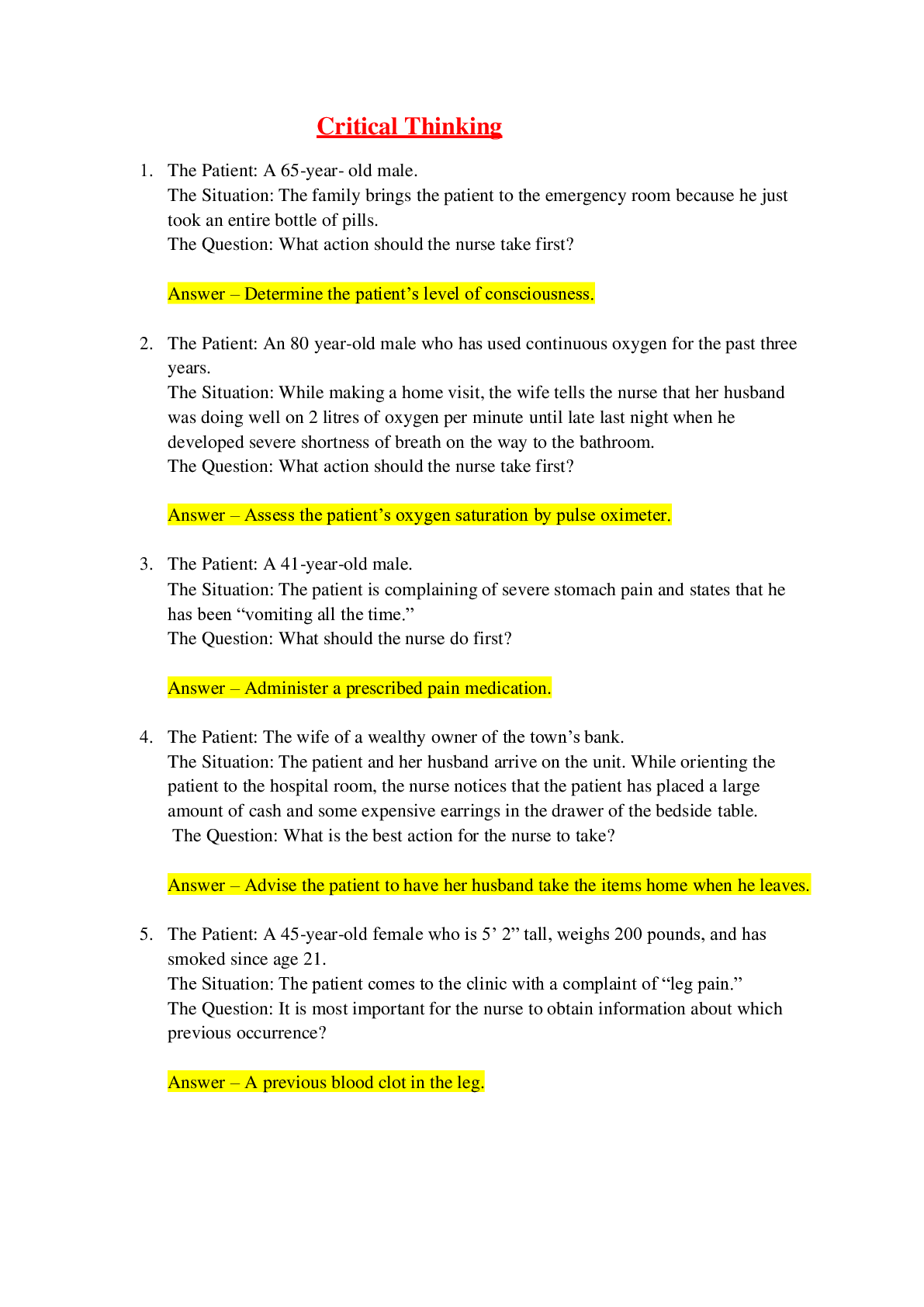
Reviews( 0 )
Document information
Connected school, study & course
About the document
Uploaded On
Apr 04, 2021
Number of pages
17
Written in
Additional information
This document has been written for:
Uploaded
Apr 04, 2021
Downloads
0
Views
52

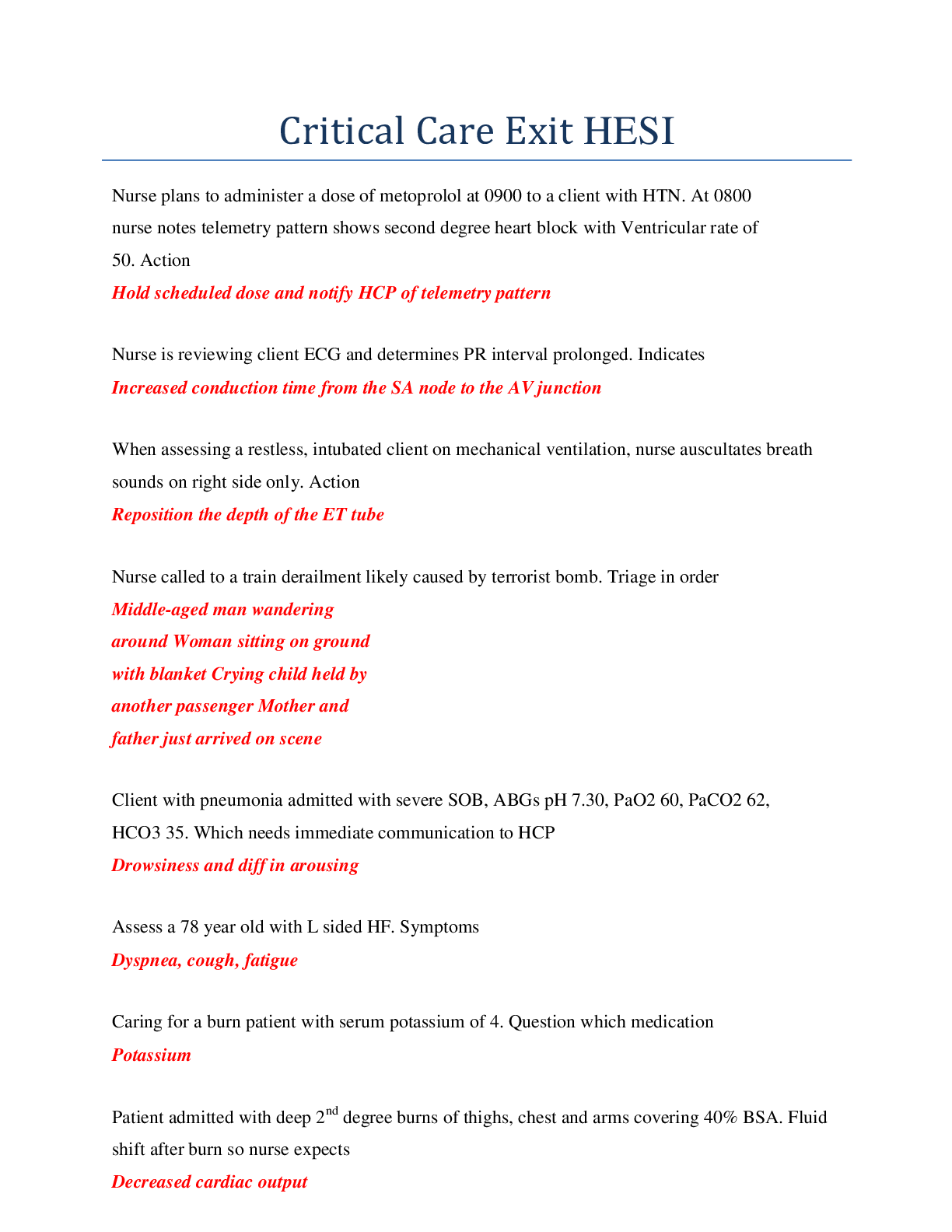
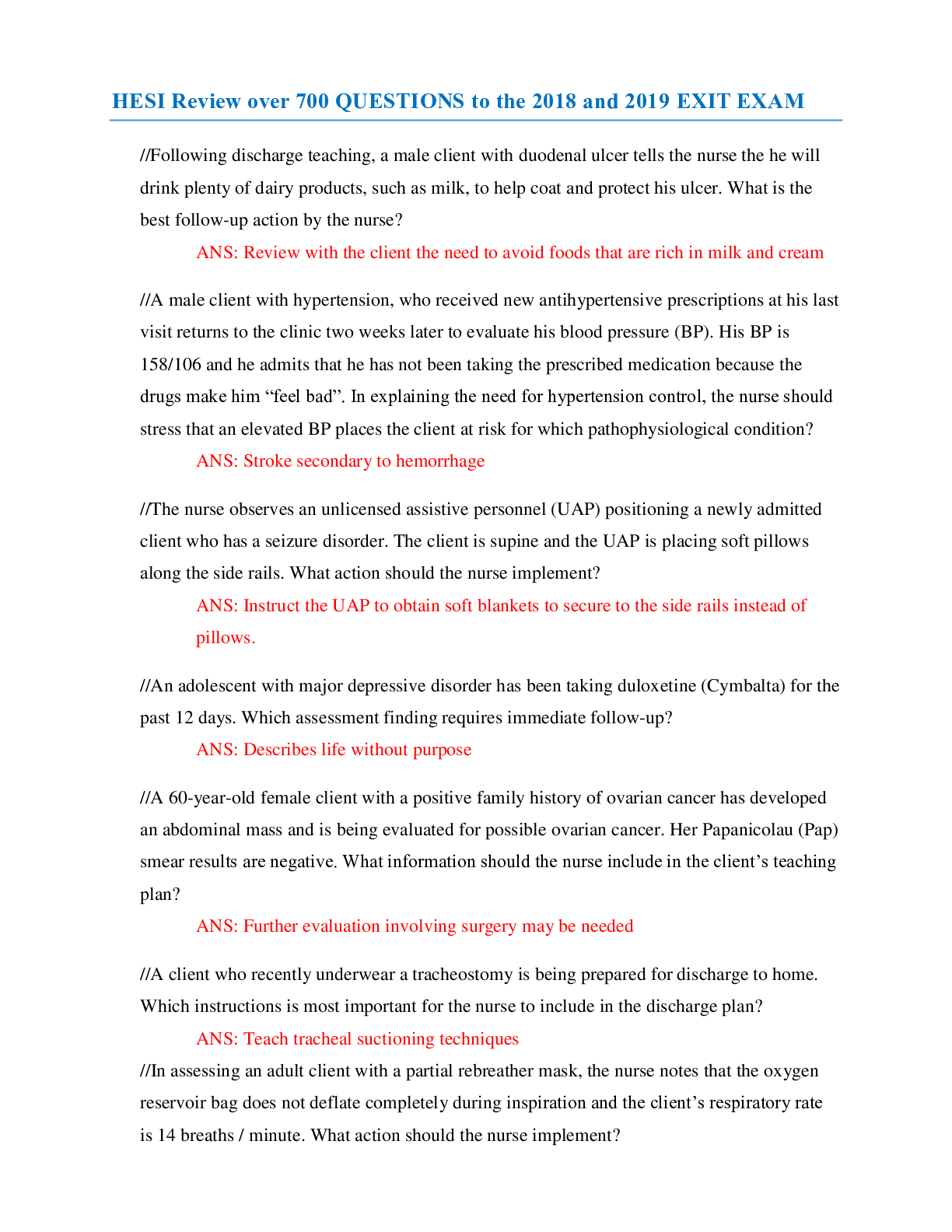
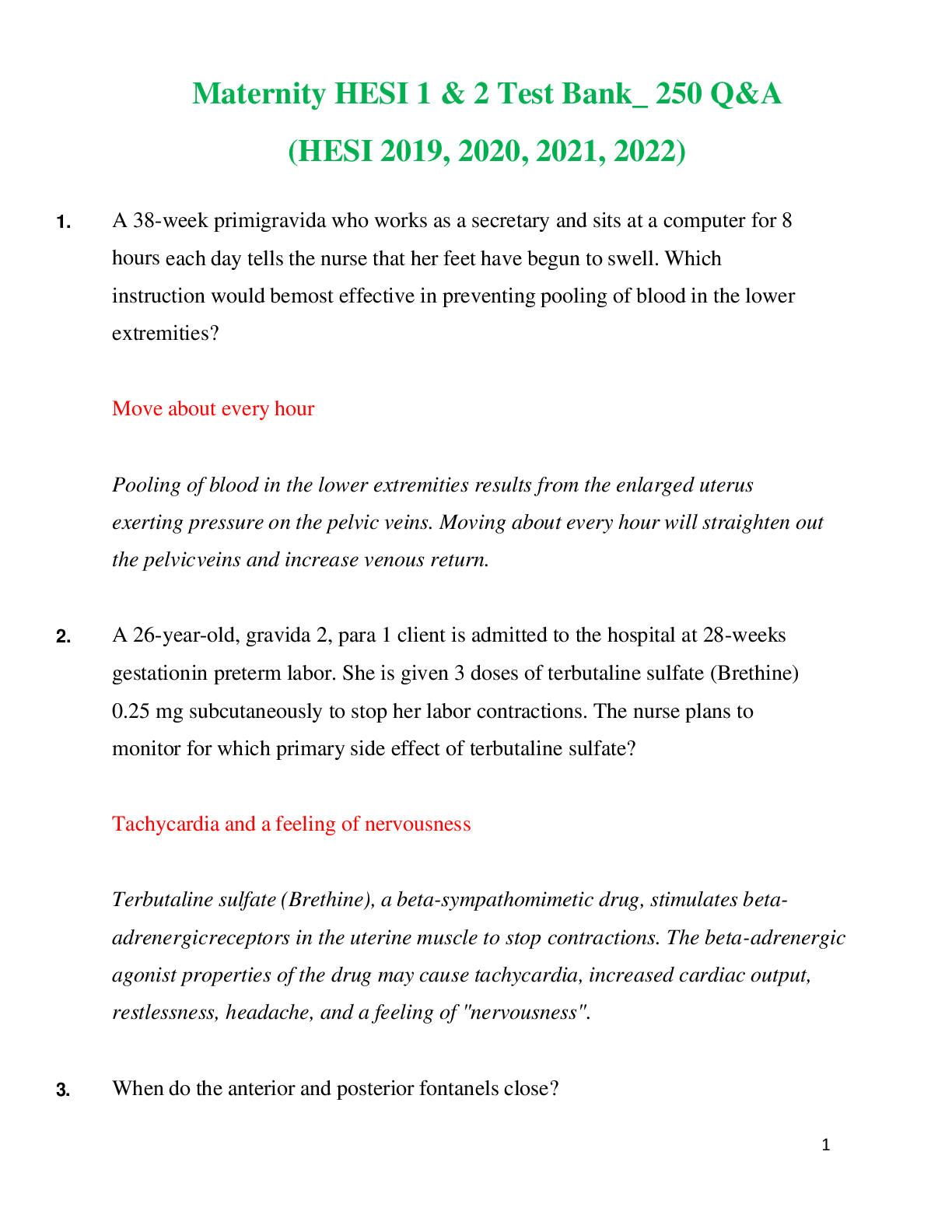
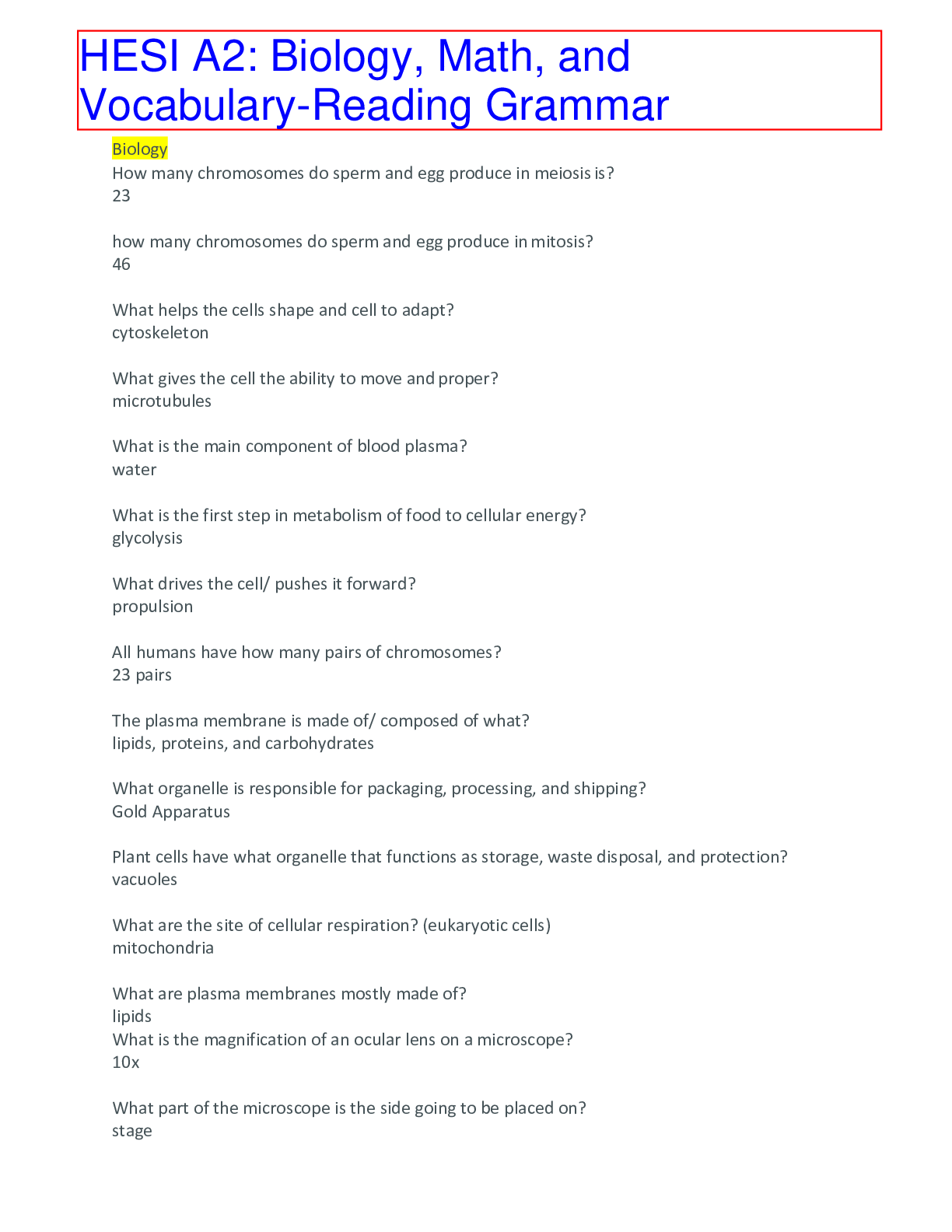
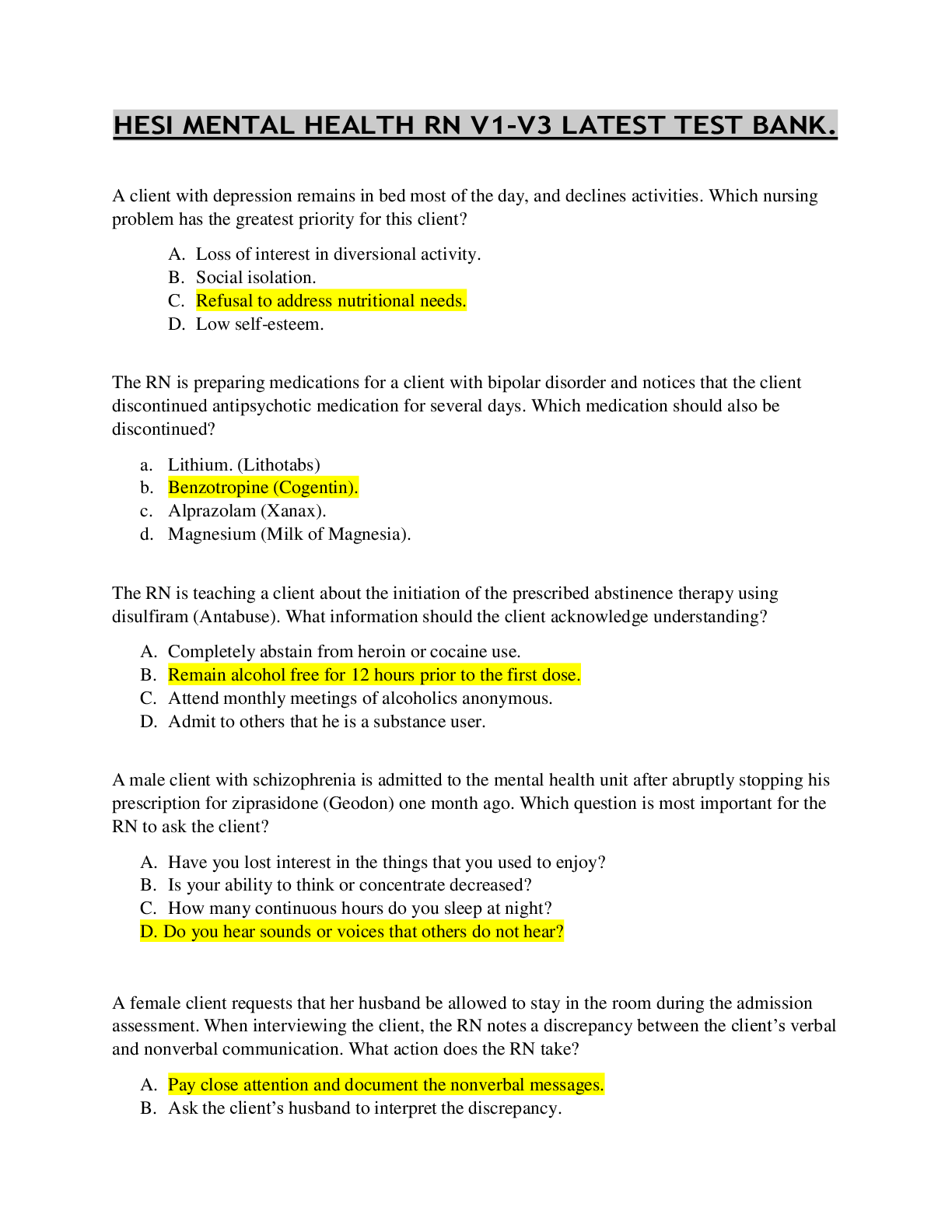
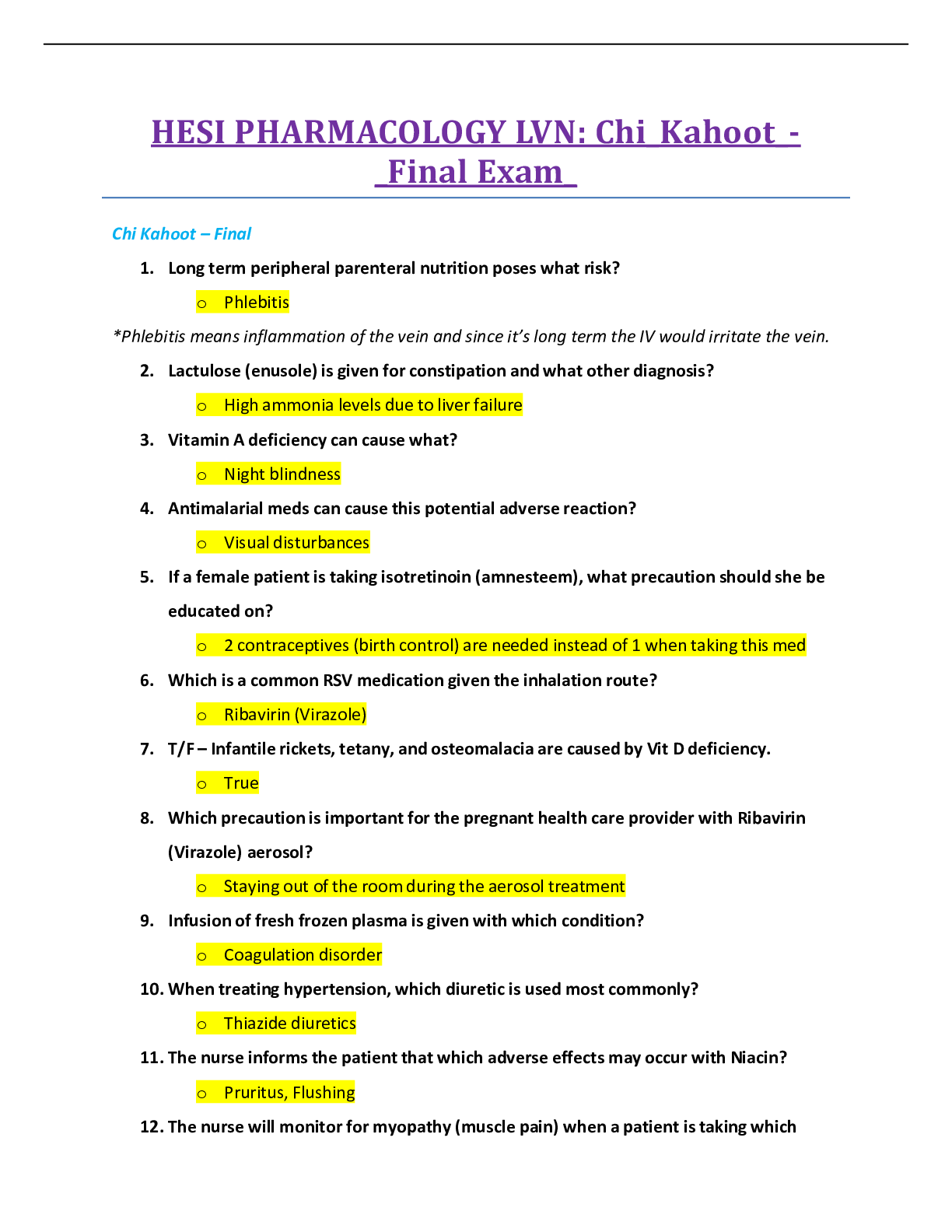
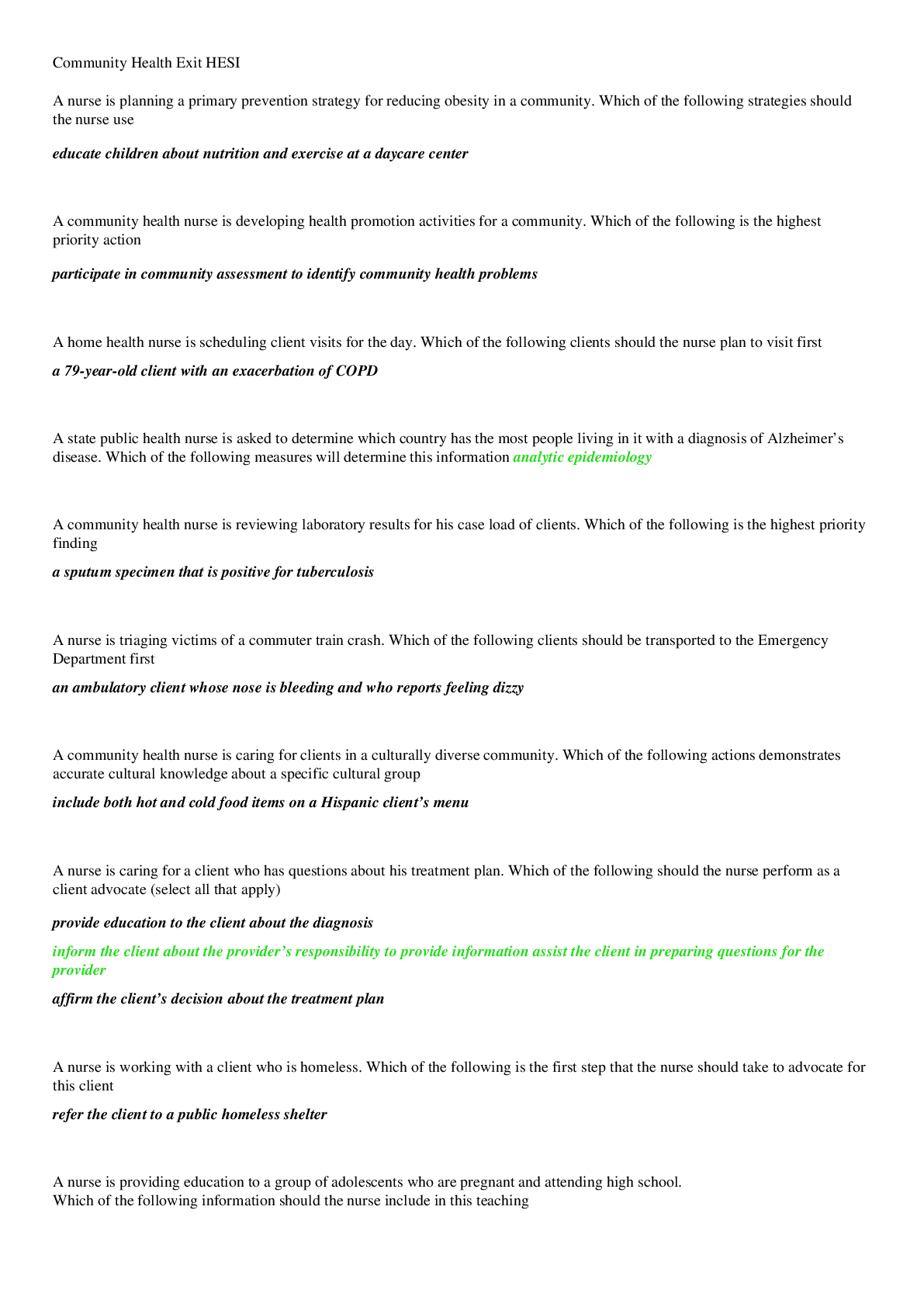
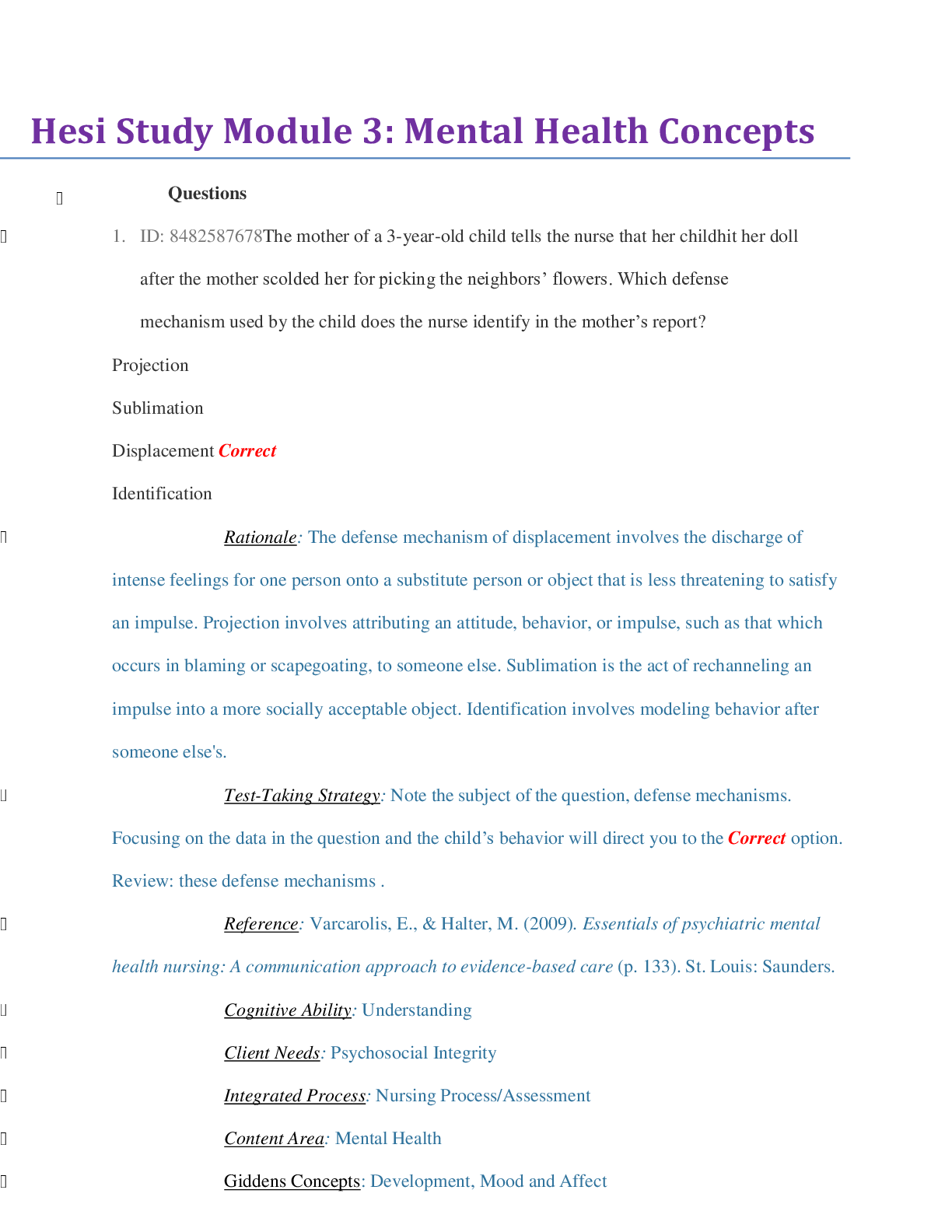
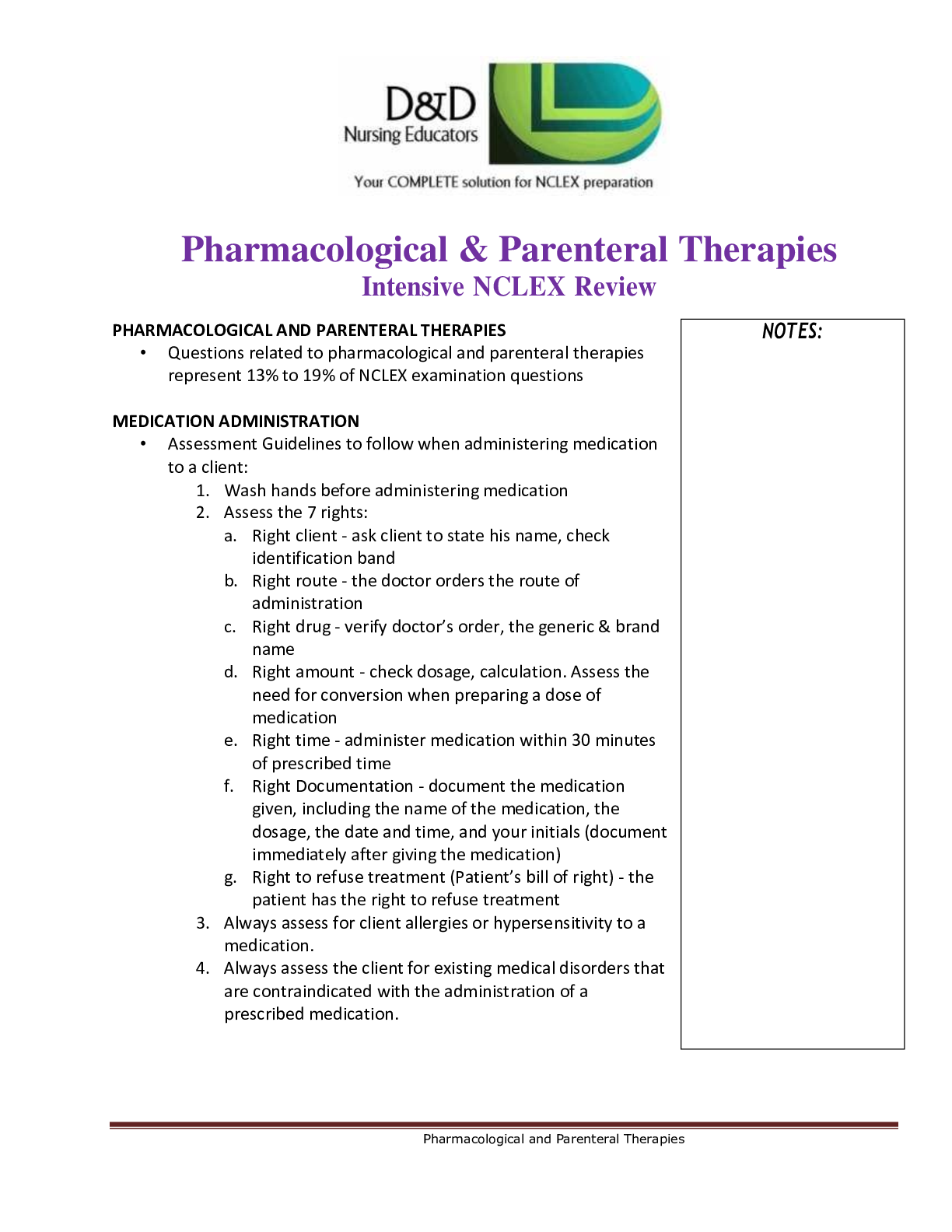
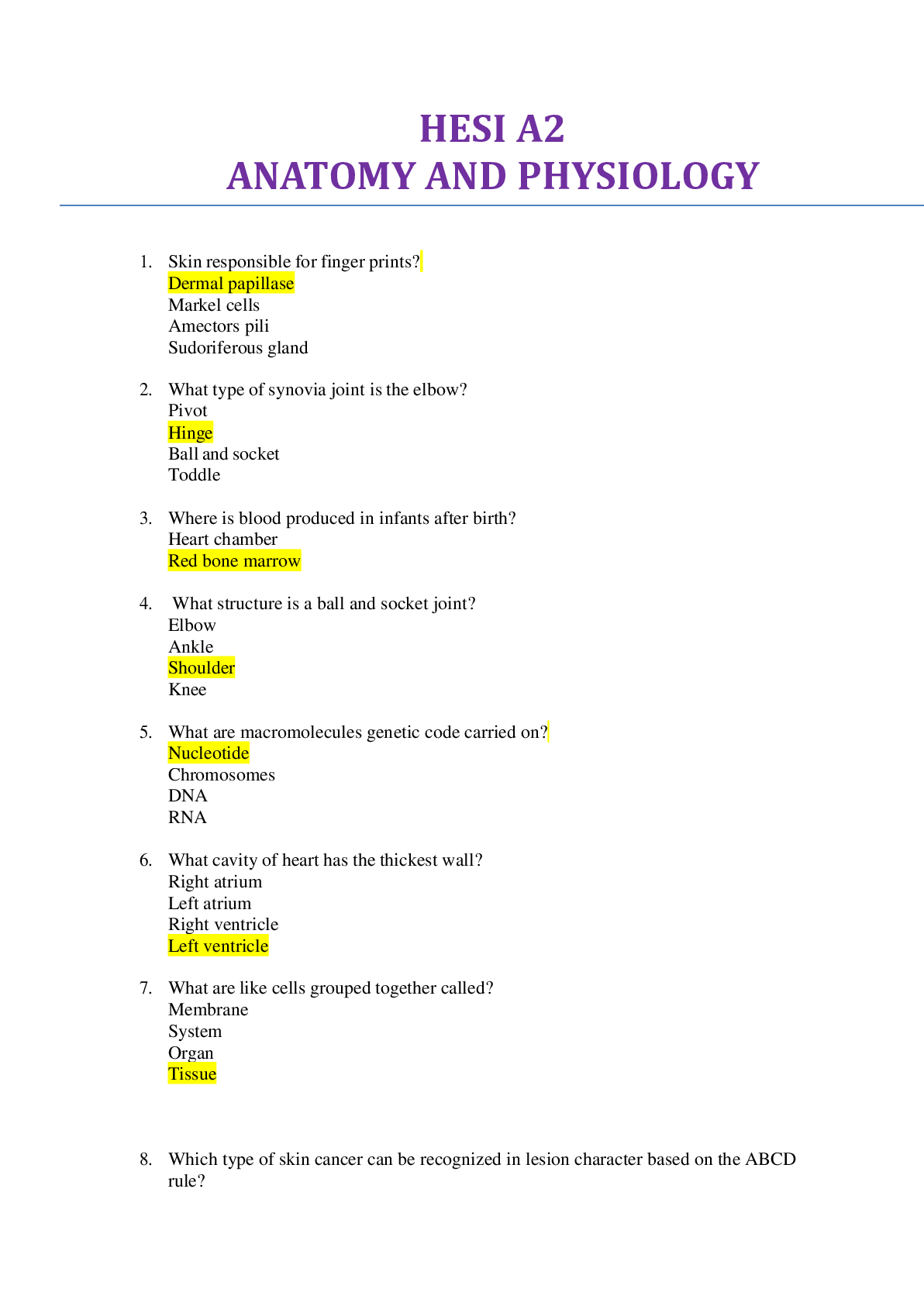
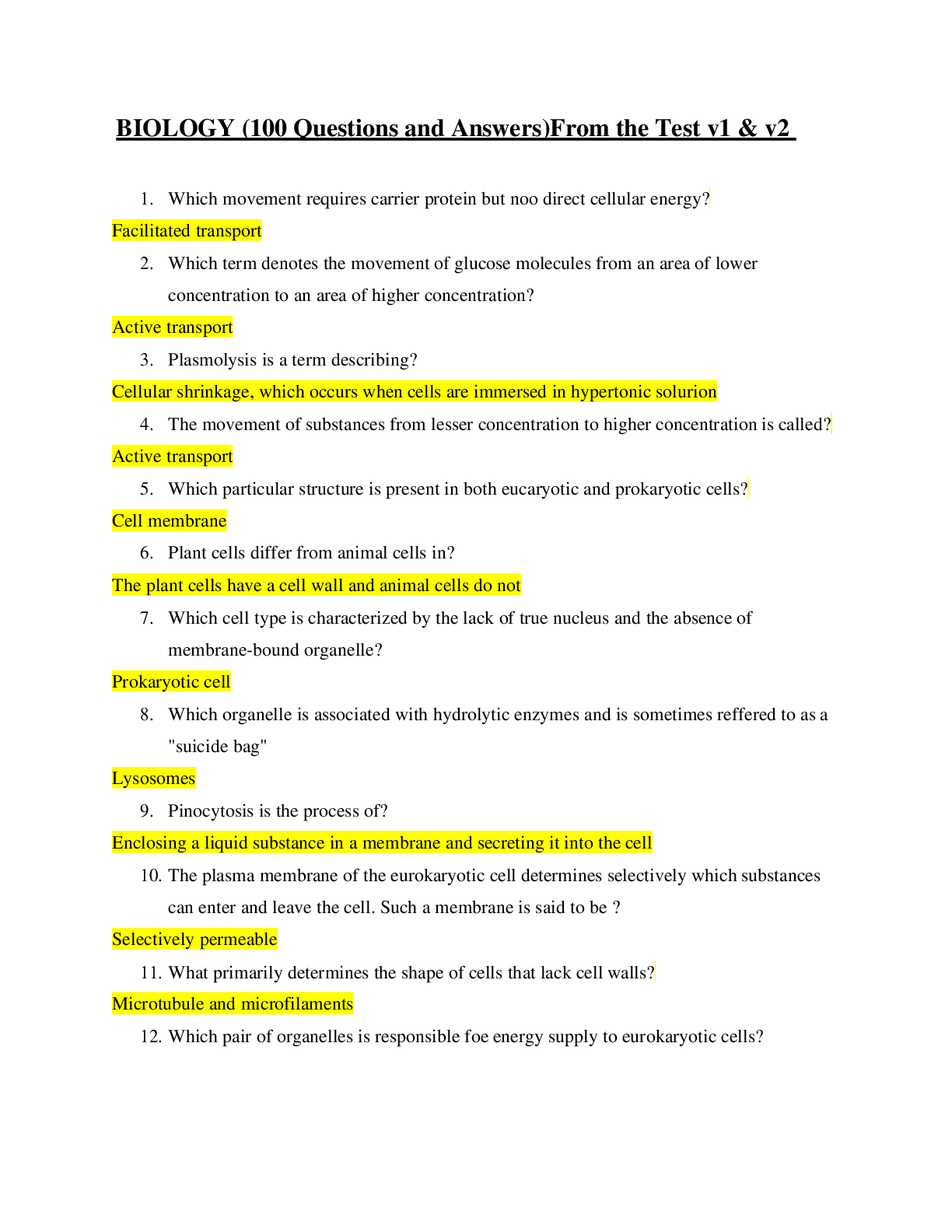
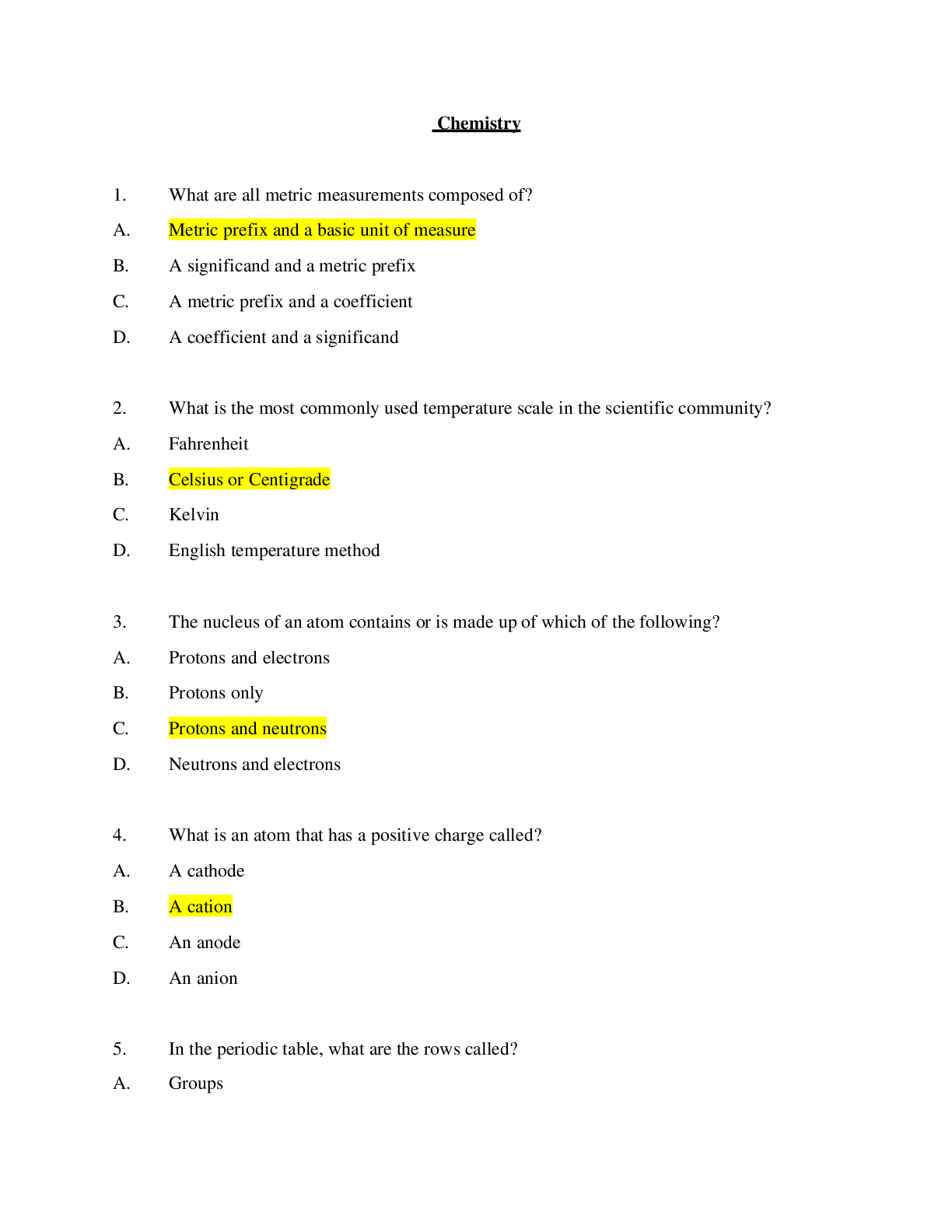
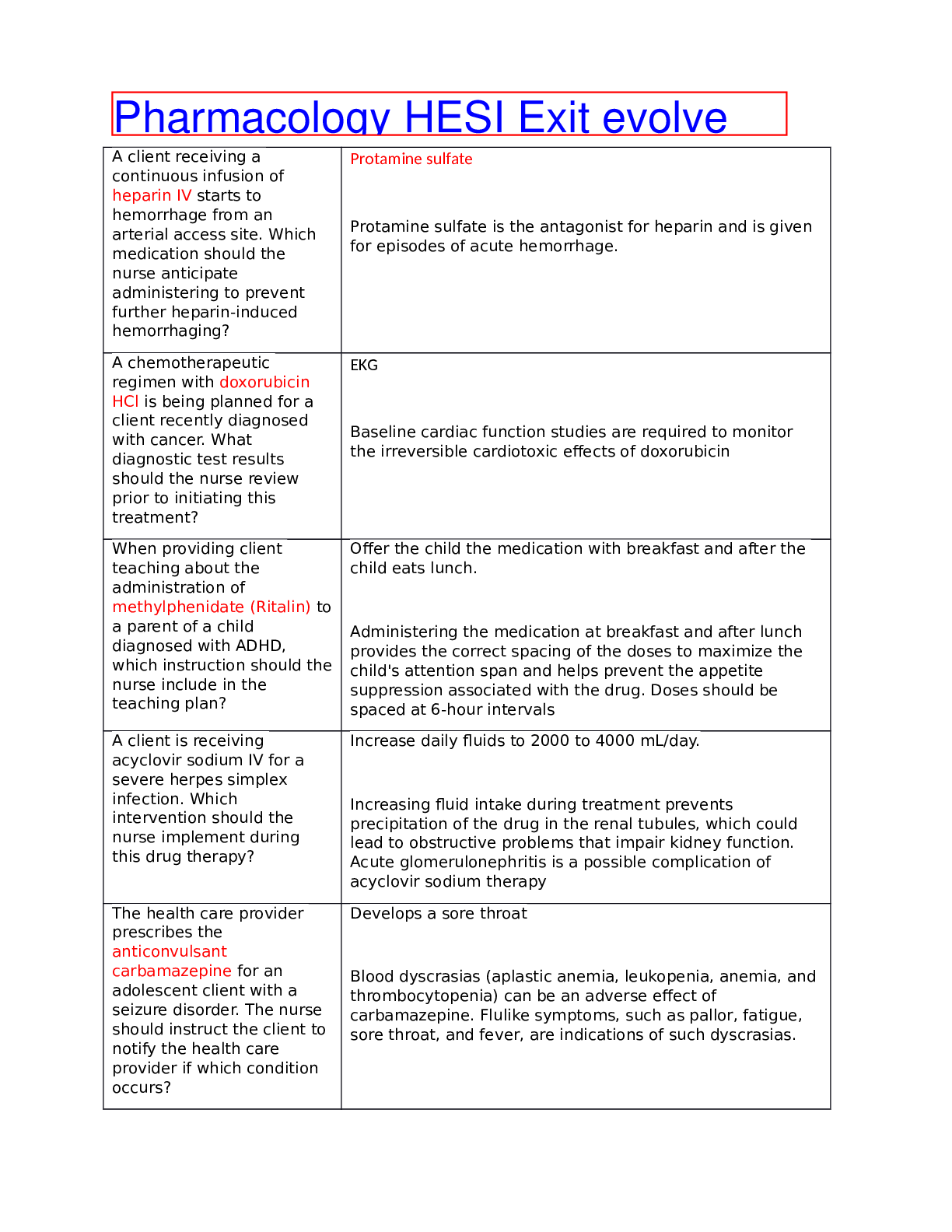
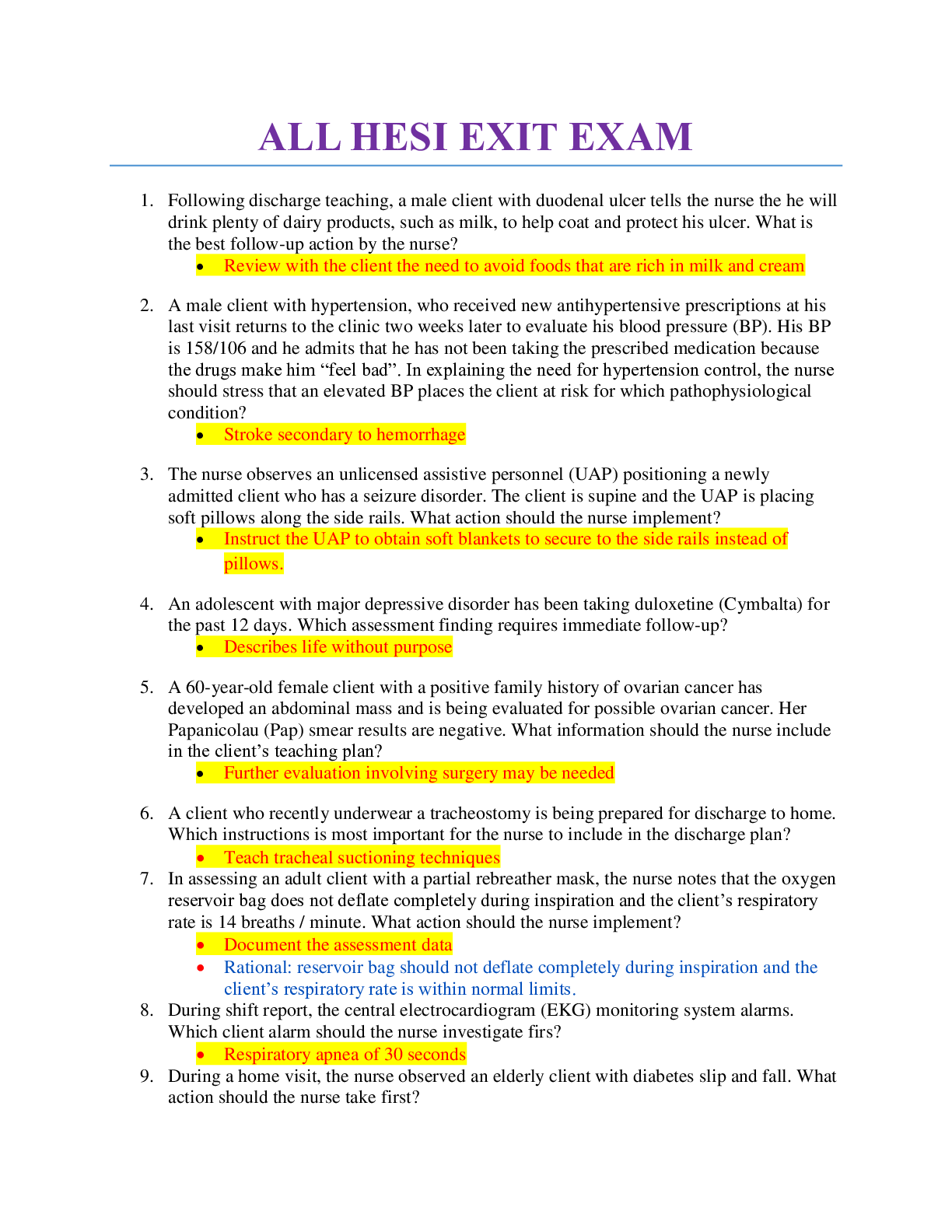


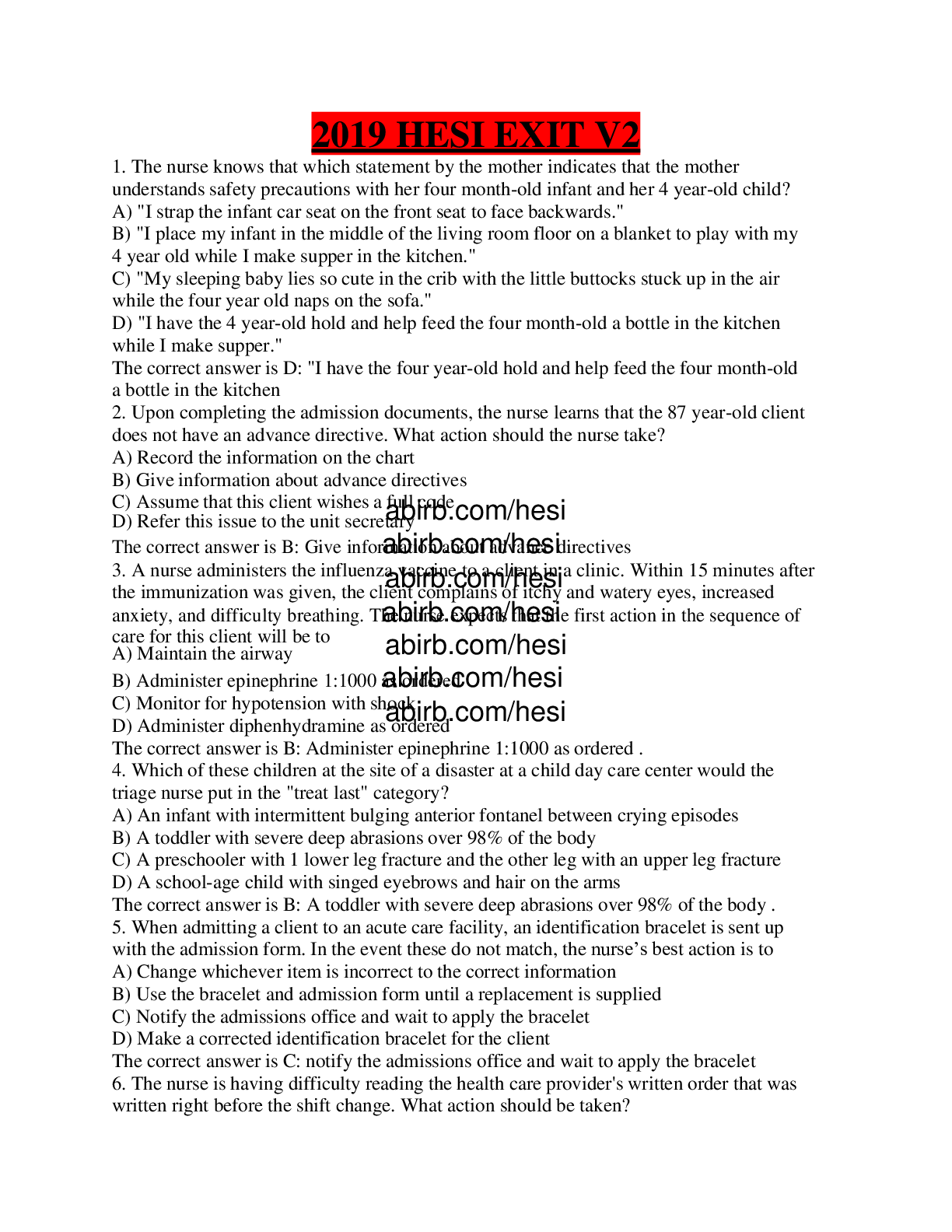
.png)
.png)
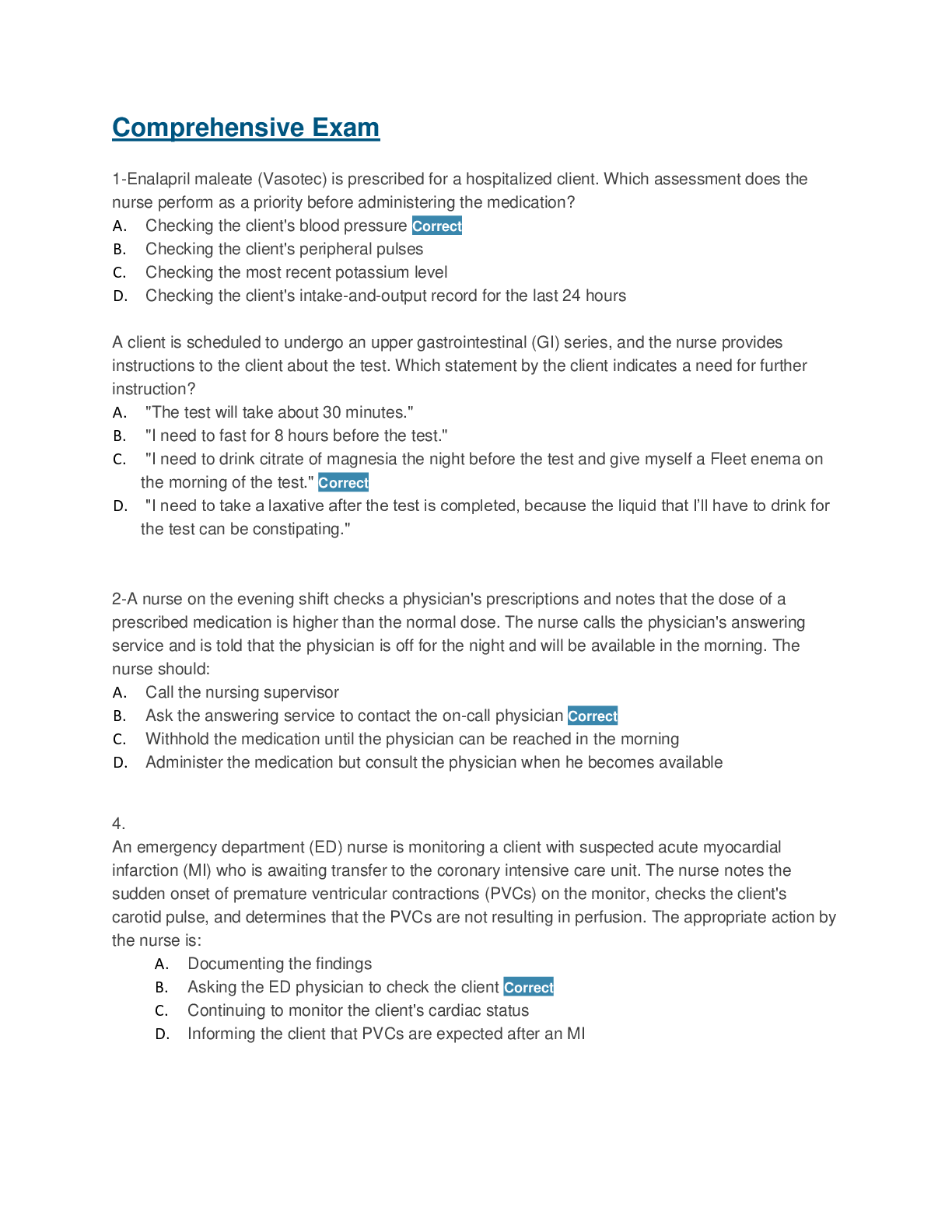
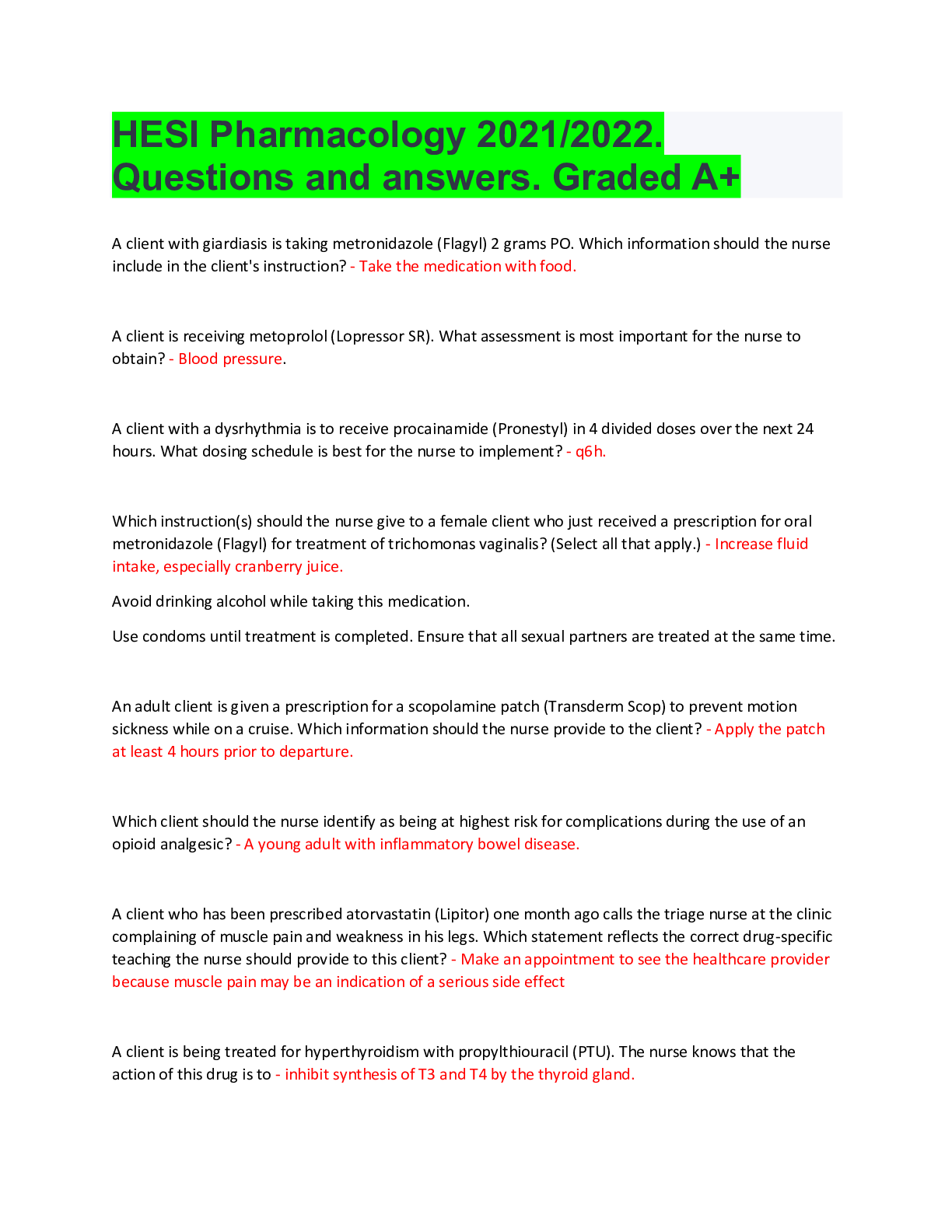
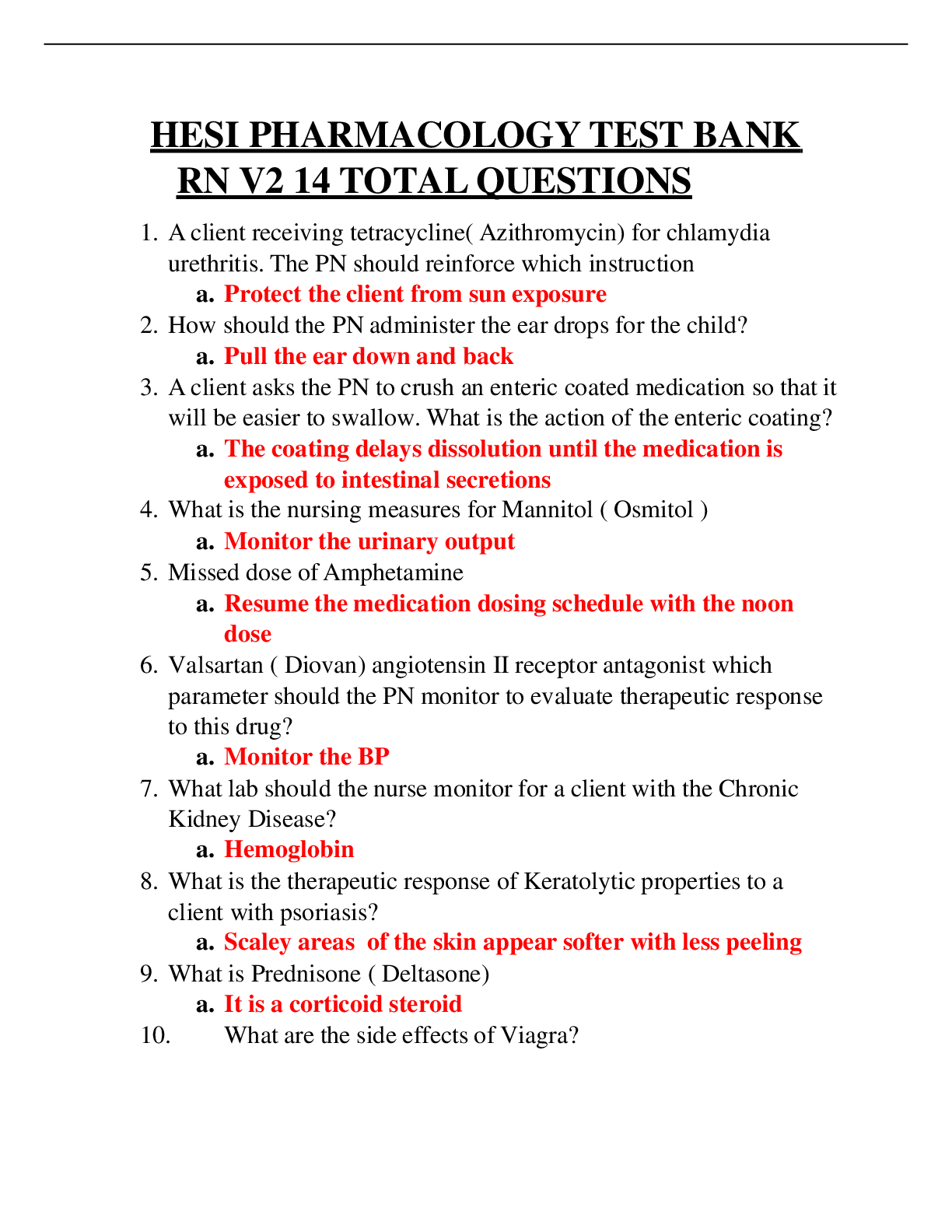
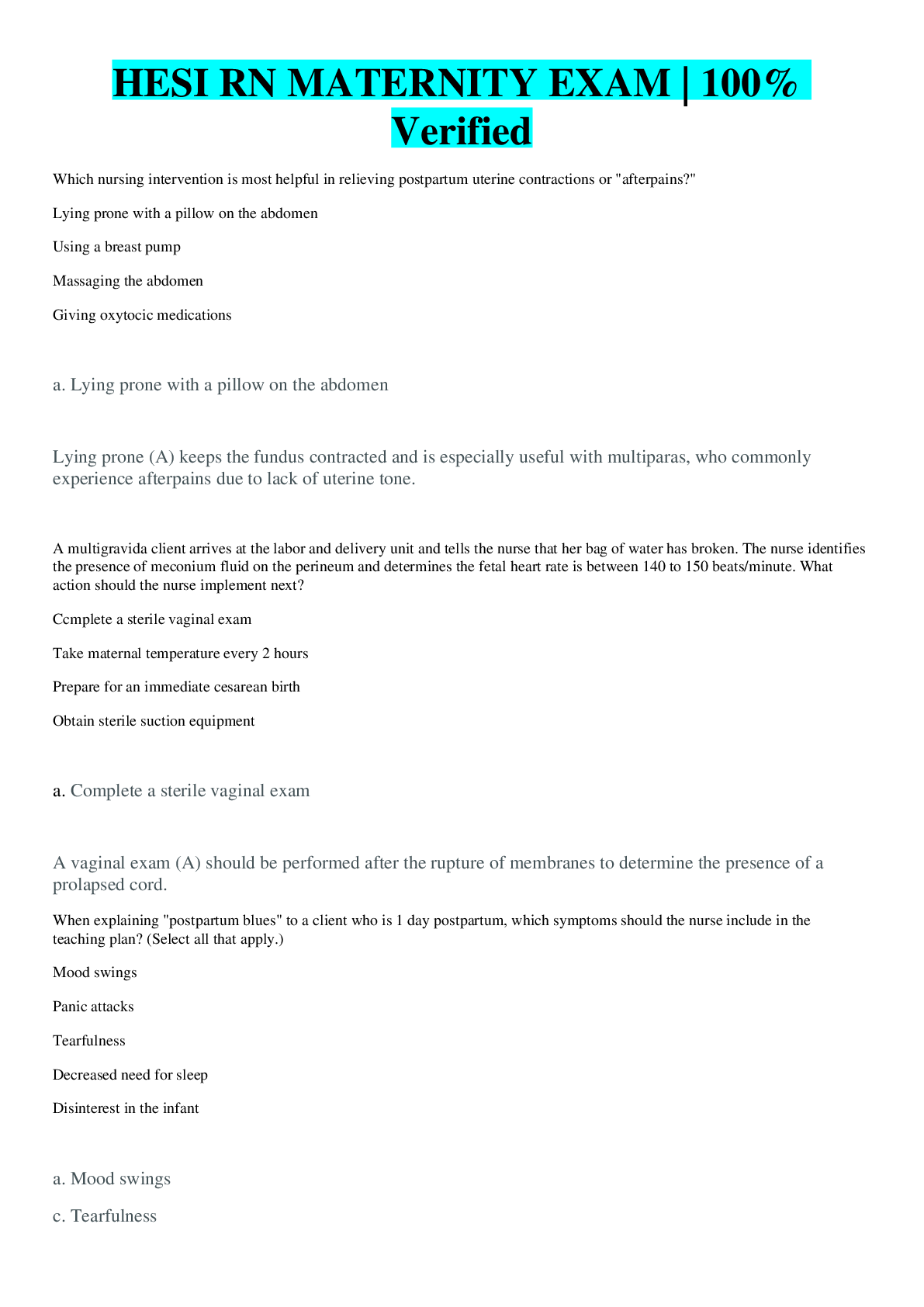
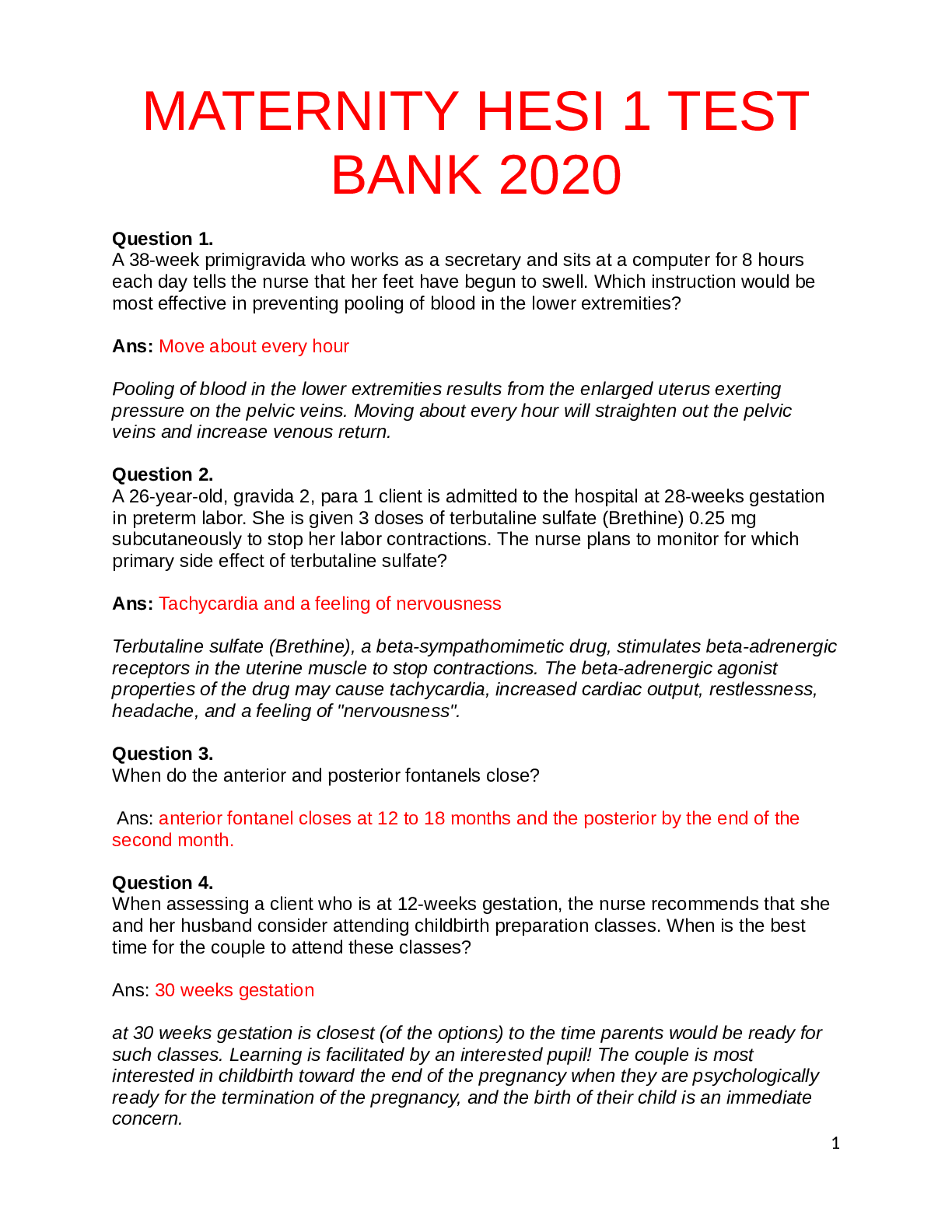
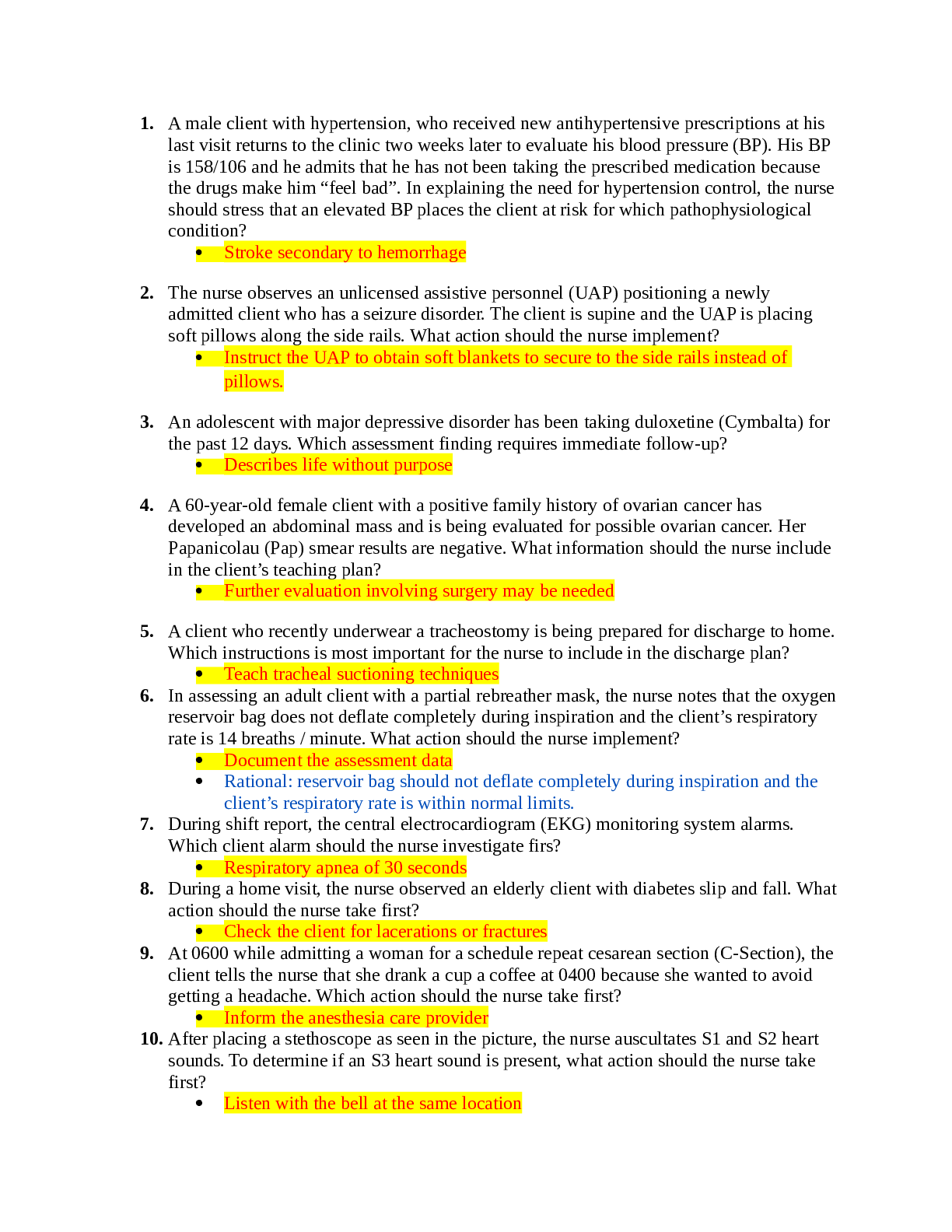
.png)
.png)
